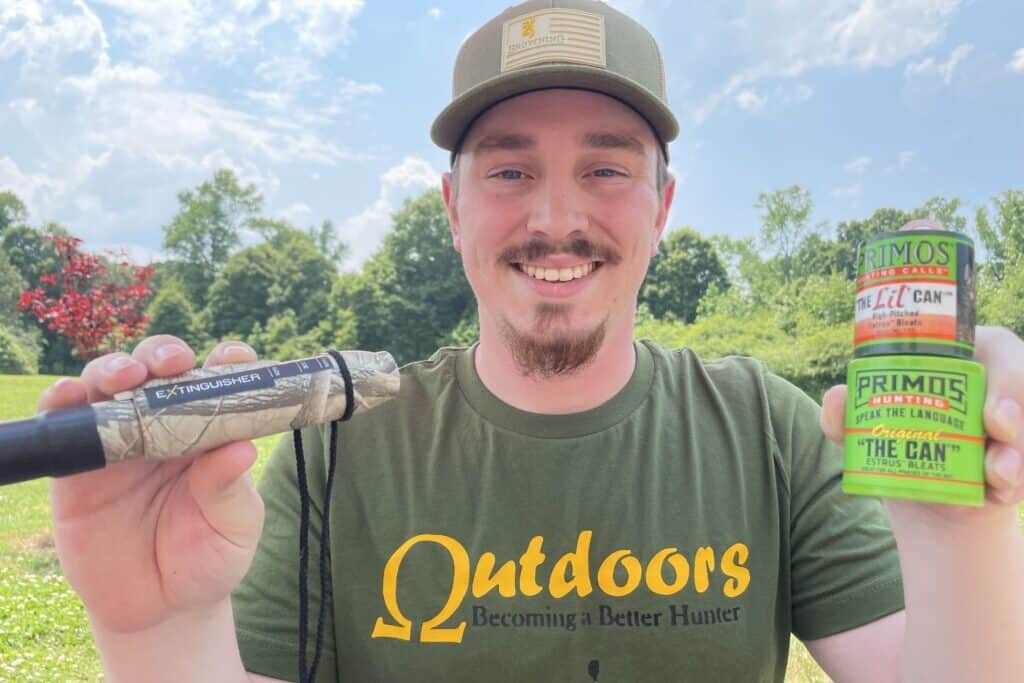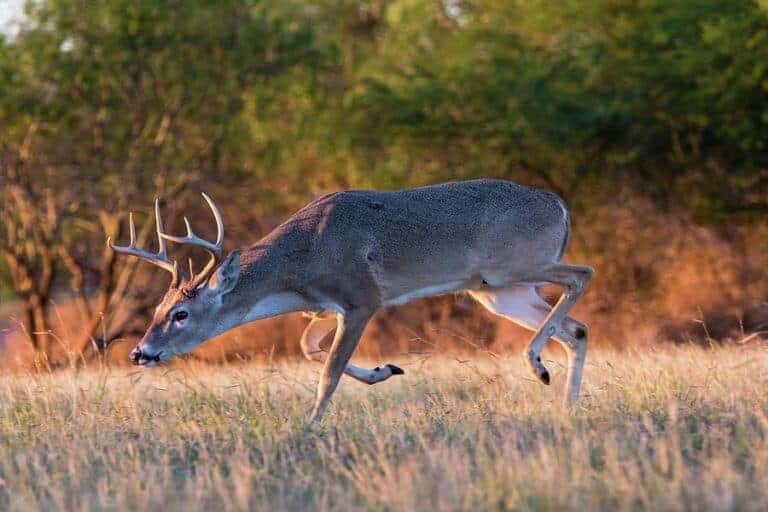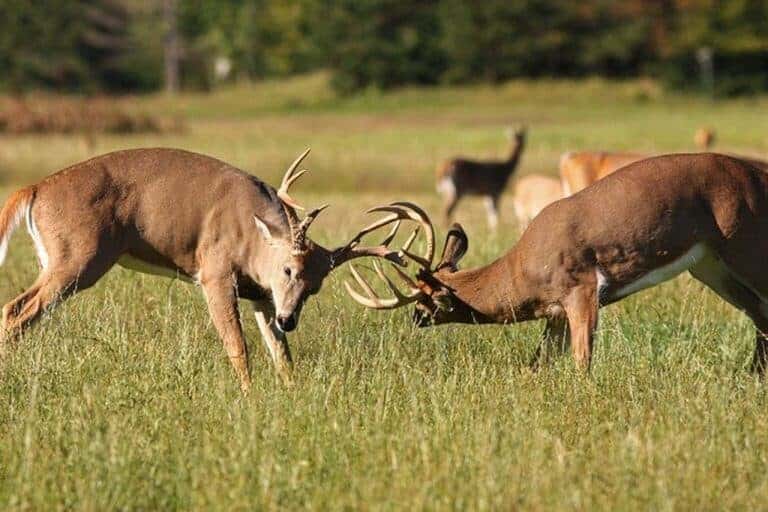Most hunters do not realize just how vocal whitetails are. Whitetail deer make a variety of calls and sounds all year long, and each one of them can mean something different. Many times we can take advantage of these deer calls and persuade them to come into shooting range. After this article, you will know almost every sound a deer can make and learn how to use them. This will lead to more harvests and help you become a better hunter.
Before we start, I thought I would quickly show you my two favorite deer calls!

In my right hand is the Extinguisher Grunt Tube. This is kind of a multi-function grunt tube that can make buck grunts, doe bleats, and fawn bleats. It is always in my pack! It is an excellent buy at less than $30 right on Amazon.com.
In my left hand is a pair of simple can calls! These calls make a doe bleat when you turn them over. They are extremely easy to use and are even cheaper at around $10 on Amazon.com.
If you already have these calls and what to learn a little more about them individually, you can read my other article on grunt tubes, “How Often Should You Grunt During the Rut?” or my guide on using the can call titled “When & How to Use the Mighty Doe Bleat“. Else, keep on reading right here!
The Gunt
The grunt is the most popular deer call there is. It is also one of the most used by deer and, therefore, by hunters. The grunt can be a very simple and useful call. You use a grunt call in two main situations. When you see a buck, and he is not coming your way, and when you do not see anything and are trying to attract a buck that may be in the surrounding area, which we call “blind calling”.
Social/Contact Grunt
This is what you think of when you think of a grunt. This is a series of 2-4 notes that are not necessarily aggressive. Both bucks and does use this grunt, although their tones are very different. Deer use this sound to say “Hey!”. It is just a normal grunt used to get the attention of other deer, and it does so nicely.

Trailing Grunt
A trailing grunt is a grunt that a buck uses when he is chasing a doe in estrus. It is a fast series of soft, muffled grunts that make the buck sound like he is out of breath. The trailing grunt is normally a rhythmic call and can be in rhythm with the steps he takes. This is the buck’s way of asking the doe to stop and breed. This type of grunt is especially useful when the rut is in full swing and during the secondary rut.
Tending Grunt
This is an aggressive deer call that bucks use when they have a doe pinned or cornered, and the buck wants to mate. It asserts their dominance, frustration, and lets everyone in the area know what he is after. This is a deep guttural call that is made of long, drawn-out notes. Typically this comes after a trailing grunt and has a snort wheeze mixed in somewhere.
Buck Roar
You will be lucky if you ever get to hear this deer call. This call should be seldom used, but it makes the list because so many hunters love to talk about it. This is a super aggressive call/roar that large dominant bucks make while chasing. This is a loud, aggressive grunt which is normally made when dominant bucks are extremely excited or angry. If you did want to incorporate it, try adding it in around one of your tending or trailing grunt calls.
The grunt is the most popular deer call out there, and it works especially well during the rut. That is why I wrote an entire article about grunting during the rut. If you want to learn more about using a grunt call during the rut, read my article here.
The Snort Wheeze
The snort wheeze is an aggressive deer call. If you are calling to a buck and he is not really paying you much attention, try the snort wheeze. This will definitely pique his interest. The snort wheeze is normally used at the end of a grunt sequence and really irritates bucks. It is pretty much a slap in the face from afar, enough to piss off a mature buck and send him your way for a fight. While it can be the perfect call at times, use it sparingly. Bucks, in general, do not use this sound often. You should use this call as a last resort.
Rattling Devices
Rattling can be a useful deer call/sound to use year-round but really shines during the pre-rut to the full rut. During the pre-rut and before, bucks will spar to find out where they sit on the totem pole. So performing a light, slow rattle during the pre-rut might pique the interest of surrounding deer as well. When the rut goes into full swing, rattling really shines. Bucks are fighting full force now for does and territory alike, so making a loud clash with your preferred rattling device can possibly send deer your way. Remember that buck fights normally only last a few minutes tops, so do not go on forever with your rattle. After a rattle sequence, wait a few hours until you try again.
PSSSSSSSST! I have two other articles about rattling that you should check out while you’re here! If you want to know if it is better to rattle in the morning or the evening, read this article. If you want to know how often you should rattle during the rut to bring in that angry mature buck, read this one!

To add to the realism, mix in a few grunts and snort wheeze calls during or after your rattling session. As a bonus, the clash made by rattling can be heard much further away than the grunt call, which will ideally attract more deer or deer that are further away. Deer are generally curious creatures, so no matter what time of year it is, they will likely want to see who the victor is or who they need to worry about.
Doe Bleat
Bucks are not the only vocal ones. Does, believe it or not, are the most vocal. They use bleats all year long to communicate with other deer, but during her estrus cycle, the tone of her bleat sounds very different. The purpose of the bleat during her estrus cycle is to signal to bucks that she is ready to mate. This is music to a buck’s ears! If she is already ready, then there is no need to chase her for days until she gives up. The best time to use this deer call is during the pre-rut and the peak rut, but do not forget about the secondary rut during the post-rut season.
If you plan on using the doe bleat, it would be a good idea to spread around some doe urine in your hunting area. This way, when a buck comes in to investigate the bleating doe, he will also be able to smell her. Also, know that the bleat call can attract bucks and does alike, so it could be a good sound to use if you are trying to find some fresh back straps. (I see you salivating…)
The doe bleat is an extremely powerful tool when you use it correctly. Personally, it has brought in plenty of deer for me. I like it so much that I wrote an entire article about how to use “The MIGHTY Doe Bleat”. If you want to learn more about the doe bleat and how to bring in deer with it, read my other article here.
Breeding Bellow
A Doe will make a breeding bellow, signaling to a close-by buck that she is finally ready to breed. This deer call is sure to get the attention of any nearby bucks during the peak of the rut. If a doe is ready to mate but not being chased by a buck, she will still let out this sound numerous times hoping to attract nearby bucks. As a hunter, this could be the golden ticket call to use during peak rut and the secondary rut.
Fawn Bleat

A lot of hunters sleep on the fawn bleat, but it is a great deer call and can really be a secret weapon. Fawn bleats normally mean that the fawn is lost, in danger, or hungry. As a fawn grows, its bleat becomes deeper and is used less and less often. So we can take advantage of this and convince nearby does that there is a young fawn around. Fawn bleats work because of the does strong maternal instincts. It is not uncommon for does to adopt lost fawns as their own without hesitation. So, if a doe hears a fawn bleat, even if it is not hers or even if she did not reproduce last year, their instincts force them to react to it and investigate.
Conclusion
Hopefully, in this post, you found a few more deer calls that you can add to your arsenal. Many of these calls have specialized uses, but some of them are good to use all year. Study these calls and learn when to use them. Check out video and audio examples other than the ones I provided here so you can get a rounded idea of what these calls sound like. Although it is not necessary to master all of these calls, learning a few of them will help improve your odds and help you become a better hunter.
Thank you for reading my article! I hope you enjoyed it, and if you have any questions or feedback, please send me an email at [email protected]. If you want to learn more about me or Omega Outdoors, visit my About Page. Otherwise, I hope you have a great day, and check out some of my other articles while you’re here!
Sister Post | How Often Should You Grunt During the Rut?
A sister post is another post that I have written that follows along with the same topic as the one you just read. After reading this article, you will probably like this next one even more! Here is a teaser…
It may come as a surprise to some, but whitetail deer are actually fairly vocal creatures and make many different sounds, especially during the rut. Actually, the grunt call is one of the best tools we have against a buck during the rut…Keep Reading
Grunt Frequency Depending On The Rut
Just like a lot of things with whitetail, the frequency at which you should blindly use a grunt call depends on the time of year. During the pre-rut…Keep Reading
Blind Grunt Calling
You use a grunt call in two main situations. When you see a buck and…Keep Reading

